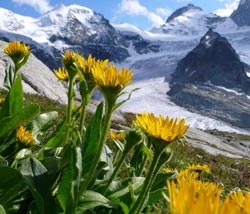Climate changes the Distribution of Plants and Animals

Plants are moving uphill due to rising temperatures. In figure: Leopard’s bane (Doronicum clusii). Illustration: Jörg Schmill<br>
Climate warming is changing the distribution of plants and animals worldwide. Recently it was shown that in the past two decades, European bird and butterfly communities have moved on average 37 and 114 kilometers to the north, respectively.
Tobias Roth and Valentin Amrhein from the University of Basel now found that in Switzerland, plant, butterfly and bird species also moved uphill. At an altitude of 500 meters, plants have on average shifted uphill 8 meters, butterflies 38 meters and birds 42 meters. The study was based on data collected between 2003 and 2010 in 214 sample areas up to an altitude of 3000 meters, covering all major ecosystems of Central Europe.
“An average of eight meters difference in altitude in eight years and across all plant species is quite impressive for the often not very mobile plant communities”, says Valentin Amrhein. “The results show that the biological impacts of climate change will not only become apparent in the long term. Animals and plants are already today adapting to the rising temperatures at a surprising pace.”
Different Trends above the Tree Line
While birds also moved uphill at higher altitudes, plants and butterflies surprisingly showed no significant changes in altitude above the tree line. Contrary to the developments in lower altitudes, alpine plants and butterflies even showed a tendency towards a downhill movement. Explanations for this phenomenon have yet to be found. “It is possible that land-use related changes in habitats near the tree line outweigh the effects of climate warming. For example, many alpine pastures have been abandoned in recent years”, says Tobias Roth. “It is also possible that alpine plants are better protected against changing climatic conditions, due to the highly varied surface of alpine landscapes.”
In any case, the fact that plant and butterfly communities have changed towards warm-dwelling species at low altitudes but remained relatively stable at higher altitudes cannot be explained with different temperature developments across altitudes. The scientists also studied data on air temperature of 14 meteorological stations: During the 16 years between 1995 and 2010, the summer temperatures in Switzerland rose by about 0.07 °C per year at all altitudes.
Original Citation
Tobias Roth, Matthias Plattner & Valentin Amrhein
Plants, birds and butterflies: short-term responses of species communities to climate warming vary by taxon and with altitude
Plos One, published January 8th, 2014 | doi: 10.1371/journal.pone.0082490
Further Information
• PD Dr. Valentin Amrhein, University of Basel, Department of Environmental Sciences, Tel. +41 79 848 99 33, E-Mail: v.amrhein@unibas.ch
• Dr. Tobias Roth, Hintermann & Weber AG, 4153 Reinach, Tel. +41 61 717 88 62, E-Mail: roth@hintermannweber.ch
Media Contact
All latest news from the category: Ecology, The Environment and Conservation
This complex theme deals primarily with interactions between organisms and the environmental factors that impact them, but to a greater extent between individual inanimate environmental factors.
innovations-report offers informative reports and articles on topics such as climate protection, landscape conservation, ecological systems, wildlife and nature parks and ecosystem efficiency and balance.
Newest articles

Silicon Carbide Innovation Alliance to drive industrial-scale semiconductor work
Known for its ability to withstand extreme environments and high voltages, silicon carbide (SiC) is a semiconducting material made up of silicon and carbon atoms arranged into crystals that is…

New SPECT/CT technique shows impressive biomarker identification
…offers increased access for prostate cancer patients. A novel SPECT/CT acquisition method can accurately detect radiopharmaceutical biodistribution in a convenient manner for prostate cancer patients, opening the door for more…

How 3D printers can give robots a soft touch
Soft skin coverings and touch sensors have emerged as a promising feature for robots that are both safer and more intuitive for human interaction, but they are expensive and difficult…





















